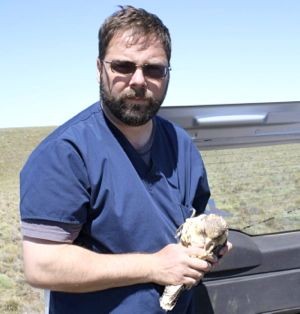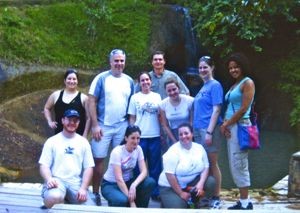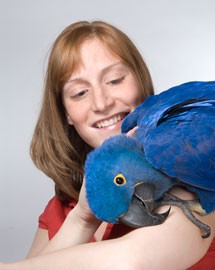1. Join or support an avian conservation team or project.
If you have skills in fundraising, publicity, graphic design, translation, photography and video recording, editing and writing, website design, biology, climbing, handling birds, or medical care of birds you may find a spot in the field, or working remotely as part of the support staff. Pick a project and stay with it as long as is mutually beneficial. The more time you can volunteer for one project the better, as conservation groups prefer to not endlessly train new people to join their team.

Dr. Miguel Saggese restraining a Patagonian falcon (Falco peregrinus cassini) in the field. Click image to enlarge.
If you do not have a lot of time, expertise, or mobility you can also participate in local bird counts such as the Great Backyard Bird Count or the Audubon Annual Christmas Bird Count.
2. Donate resources to avian conservation.
There are a plethora of worthwhile avian conservation projects to which you can donate supplies, equipment, and funds. Some projects may not fit your particular vision or area of passion, and other projects may not use donations prudently. How can you tell without becoming an expert in avian conservation?
You could donate to a metaconservation group, such as Bird Life International, the National Audubon Society, or the American Bird Conservancy and let them decide. Or familiarize yourself with smaller specialty groups such as Parrots International and World Parrot Trust. Whatever you decide to do, check the organization’s website for its mission and objectives. Also look at financial reports to evaluate overhead, results, and organizational partners.
3. Know the origin, ecology and behavior of any bird you work with or wish to acquire.
Know the origin, ecology and behavior of any bird you work with or wish to acquire.
This knowledge and understanding aids you in caring and making decisions that best suit birds in their native habitats. Use books, articles, videos, interviews, and the Internet. See the International Union for Conservation of Nature and Natural Resources for their global list of endangered and threatened birds as well as the North American list of endangered and threatened birds published by the Cornell Lab of Ornithology.
The well being of birds and the environments in which they live are directly related to the health of human communities. For instance, poverty and loss of biodiversity are intimately linked. Avian conservation efforts increasingly include human health and well being in their research objectives and solution protocols. It is more difficult to procure information about human communities in relation to birds, but start with Bird Life International and RARE Conservation.
4. Promote education and awareness in others.
Offer information about avian conservation in your clinic:
- Play videos from youtube.com or bird conservation sites. For instance, check out The Honduran Emerald Hummingbird in Amazing Slow Motion by the American Bird Conservancy.
- Provide brochures and handouts about avian conservation. Download the American Bird Conservancy’s free PDF brochure on Cats Indoors Program.
- Have a computer available to search for and display conservation projects.
- Display posters on avian conversation.
- Sell books and other items that support avian conservation projects.
While working with birds or talking to friends, family, and acquaintances about your work or the birds in your life, share with them what you know about the status of these birds in the wild. Engage in social and informational networks like Twitter and Facebook, and offer presentations to local civic and community groups, including bird clubs and veterinary associations.
5. Care for birds in captivity while questioning their existence in captivity.
One of the best ways to “conserve birds” is to care adequately for those already in our midst. To do so we need to understand their complex natures as best we can so we can provide them with an enriching and healthy environment. In reality, there is no way an artificially constructed environment can match the complex ecological and social niche that has evolved for birds.
For this reason, one must consider carefully the moral obligations humans have whenever they consider having a wild animal in captivity. For many, the question is not how to provide a good life for a bird, but whether most bird species should be in captivity in the first place. Understanding how birds come into captivity or into your homes (often through conditions that cause suffering, death, extinction, and environmental and biodiversity degradation) deters many from keeping birds in captivity. If birds are to come into captivity, they should be fairly traded, organic, sustainable, and humanely reared. This means that people who work with birds earn a living wage, that the environment and the bird is not harmed in the process, and that the bird and her or his parents have a wonderful life throughout their time spent with humans.
6. Strive for a low carbon footprint, making your home and work environments as “green” as possible.
The more we consume of the earth’s resources, the less there is for other life forms. We may not see the devastation that our consumer choices cause, however, much of what we have comes from other peoples and birds losing their habitats if not their very lives. For instance, the habitat of the yellow-billed parrot (Amazona collaria) in Jamaica is threatened by zinc mining, so the more we recycle, the less environmental impact there is for this species. Other small daily steps can also positively impact lives. Eat low on the food chain (i.e. vegetarian) as much as possible, utilize less petroleum products (i.e. drive less, cool and heat homes less, buy local food and products, etc.), and generally do with less (i.e. smaller homes, yards, cars, wardrobes, and gadget collections).
7. Support organizations that promote avian conservation.
Visit or vacation at a sanctuary, park, or avitourist destination. Your dollars help sustain the viability of programs that seek to protect and nurture birds and people. Though we are trying to reduce consumerism, which also means less traveling and purchases, if you can target your spending for goods that support people and their efforts to live sustainably, you are helping birds. In turn, as we nurture humans, we nurture the environments in which they live. Learn more by visiting the International Ecotourism Society and the agencies listed in Ten Things Every Avian Veterinarian Should Know About Conservation Medicine.
8. Support an advocacy group.
There is always work to be done on the local and international level for legislation and policy that protects and nourishes birds and the world in which they live. Though there is greater public awareness about the choices that reflect compassionate care for life and environmental values, human societies need not just education, but public policy to provide in-depth, timely, and far reaching guidelines for enacting change.
Find out more at the:
- American Bird Conservancy
- Avian Welfare Coalition
- Environmental Protection Agency
- National Audubon Society
9. Support students wishing to study avian conservation at home and overseas.
People who are native to the particular region where avian conservation projects focus bring longevity, embodied understanding, commitment, and an ability to navigate the complex world of their particular location. Therefore one of the best ways to support avian conservation is to provide educational support for students in conservation biology, wildlife management, and veterinary medicine.

Lafeber Company was a sponsor of a Cornell College of Veterinary Medicine trip to Honduras. Click image to enlarge.
You can also support international student and veterinarian travel. For instance, the Association of Avian Veterinarians provides scholarships to students and international veterinarians to attend their conferences. You may also contact Dr. Dennis Guerro Centeno at the San Carlos School of Veterinary Medicine and Zoology who seeks scholarship support for graduate students studying psittacine conservation in Guatemala .
10. Grow your enjoyment of birds and encourage others to do the same.
Birds are beautiful and bring much pleasure and enjoyment. When watching them we grow in our sense of their beauty, which calls us to greater care and compassion of our natural world.
“[T]he experience of beauty has a built-in consequence: fairness.
(It) refers both to loveliness and to the ethical requirement to be
fair, play fair, or distribute fairly. Beauty issues a call to symmetry
and equality, a call to be just.” –Elaine Scarry
Bird watching is avian conservation in the making, and estimates of American birdwatchers range from 46 million to over 60 million. Carry binoculars when you go walking or keep a pair in your car. Take time to slow down and observe birds. They’ll surprise you with their behavior and beauty. While at work and at home ask others if they had any interactions with birds and what they thought and felt. In their relationships with birds, were there aspects that brought them joy and peace, understanding and clarity, sadness and loss? If we can take time to celebrate, mourn, and express gratitude with others about our lives with birds we grow our capacity to care, and renew ourselves so that we may work diligently and consistently over the many years it will take to save even one species.
Visit Birding.com and the National Audubon Society to learn more about bird watching.
Joyner L. Ten things you can do to promote avian conservation. July 22, 2009. LafeberVet Web site. Available at https://lafeber.com/vet/ten-things-you-can-do-to-promote-avian-conservation-2/



